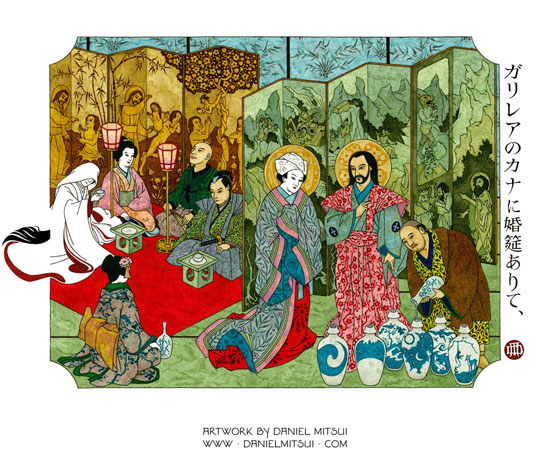
This is the fifth commission I have received to transpose a Christian subject from medieval European art into the style of Japanese art. Various Japanese woodblock prints of the 18th and 19th centuries were used for visual reference. Paintings by Hinrik Funhof, Hieronymus Bosch, Gerard David and Bertram von Minden were among the occidental works that influenced the content and arrangement.
The Wedding at Cana is depicted in the middleground as a Japanese marriage ceremony, with the bride wearing the traditional garb, about to sip sake. Christ and Mary converse in the foreground, while a servant fills the six stone jars with water.
The images on the jars and on the folding screens that divide the sections of the drawing illustrate the theological significance of the Wedding at Cana. Because the Sacrament of Marriage is so closely associated with the story of Adam and Eve (But from the beginning of the creation God made the male and female. For this cause, a man shall leave his father and his mother and shall cleave to his wife; and they two shall be in one flesh), I drew on the golden screen behind the wedding party the creation of Adam, the creation of Eve and the temptation of them both.
The Church Fathers saw in the six jars a symbol of the six days of creation, and the designs on the jars (which are shaped like sake vessels) represent these: the creation of light, the firmament, the land and plants, the heavenly bodies, the birds and fish, and the beasts.
St. Augustine also saw in them a symbol of the six ages of the world, and his commentary I depicted on the green screen behind Christ and Mary:
Prophecy, which is dispensed from the ancient times, has for its object the salvation of all nations... That this may appear more agreeably, let us ... mention certain facts respecting the several ages, as represented respectively by the water pots.The inscription on the right side of the drawing reads: There was a wedding at Cana of Galilee. I used the translation of the New Testament into classical Japanese done by the Belgian missionary Emile Raguet in 1910.
In the very beginning, Adam and Eve were the parents of all nations, not of the Jews only; and whatever was represented in Adam concerning Christ, undoubtedly concerned all nations, whose salvation is in Christ. What better can I say of the water of the first water pot than what the apostle says of Adam and Eve?...
Christ was represented also in Noah and in that ark of the whole world. For why were all kinds of animals shut in the ark but to signify all nations? For God could again create every kind of animal.... Were it not that He was setting before us a mystery, and filling up the second water pot of prophetical dispensation, that the world might by the wood be delivered in a figure; because the life of the world was to be nailed on wood.
Now, in the third water pot, to Abraham ... it was said: In thy seed shall all nations be blessed. And who does not see whose figure Abraham’s only son was, he who bore the wood for the sacrifice of himself, to that place whither he was being led to be offered up?...
But as to David, why do I say that his prophecy extends to all nations, when we have just heard the psalm.... Arise, O God, judge the earth; for Thou shalt inherit among all nations?...
Moreover, in the fifth age, in the fifth water pot as it were, Daniel saw a stone that had been cut from a mountain without hands, and had broken all the kingdoms of the earth; and he saw the stone grow and become a great mountain, so as to fill the whole face of the earth.... The stone is cut from a mountain: the same is the stone which the builders rejected, and has become the head of the corner. From what mountain is it cut, if not from the kingdom of the Jews, of which our Lord Jesus Christ was born according to the flesh? And it is cut without hands, without human exertion; because Christ sprung from a virgin, without a husband’s embrace....
To the sixth age belongs John the Baptist.... And how did John show that Christ was sent to all nations? When the Jews came to him to be baptized, that they might not pride themselves on the name of Abraham, he said to them, O generation of vipers, who has proclaimed to you to flee from the wrath to come? Bring forth therefore fruit worthy of repentance; that is, be humble; for he was speaking to proud people. But whereof were they proud? Of their descent according to the flesh, not of the fruit of imitating their father Abraham.
Medium: Drawing, color ink on Bristol board
Dimensions: 12" × 9"
Year: 2014
The original drawing was made on private commission.
Open-edition giclée prints of this drawing are available. You may use the buttons below to pay via PayPal, debit card, or credit card. Be sure to confirm the shipping address.
|
Actual size art print: $88
|
22" × 17" large print: $176
|
200dpi digital download: $18

|
See this page for additional ordering instructions and general information. If you want to pay via a check or money order, please e-mail me at danielmitsui@danielmitsui.com.
